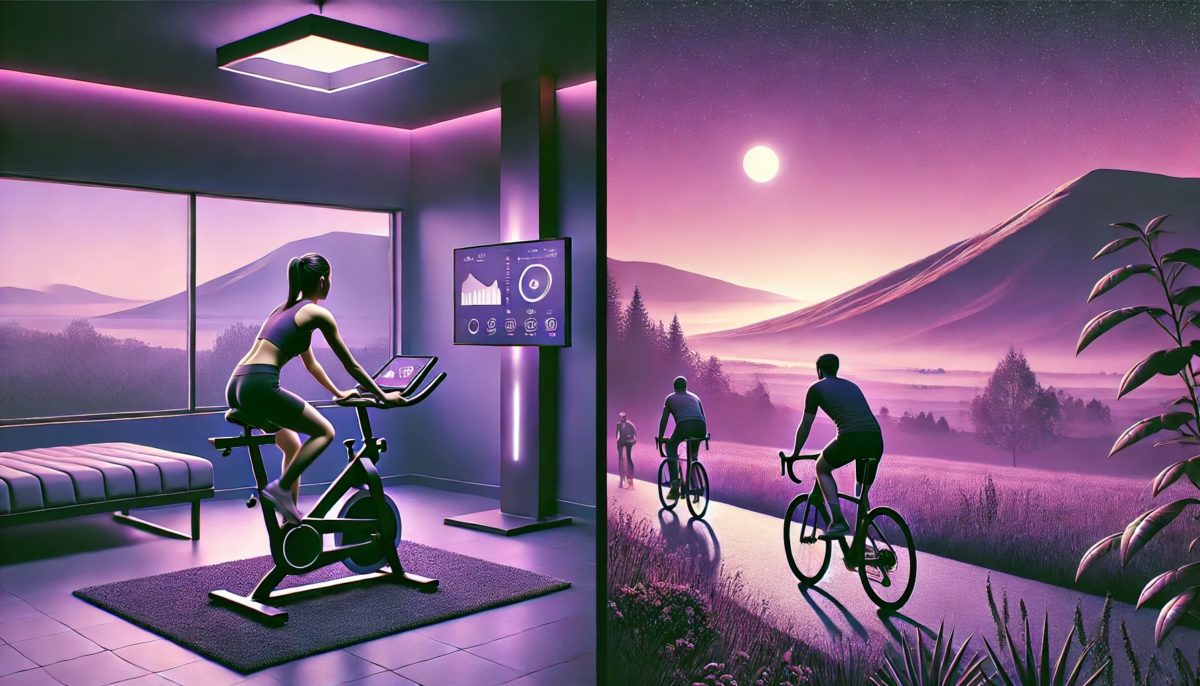When it comes to cycling training, the choice between indoor and outdoor is far from trivial. It’s not just about comfort, but about different physiological, technical, and psychological stimuli that can significantly influence overall performance.
Today, cycling training is no longer just about leaving home and racking up miles on the road. The options have multiplied: classic outdoor rides, home trainer sessions in the living room, spinning classes, and even immersive and social indoor training platforms like Zwift. With so many possibilities, it’s natural to ask: is it better to pedal indoors or outdoors? And most importantly, what really changes between the two? Let’s explore how to integrate both into your routine.
Physiology, Biomechanics, and Environment
- Indoor (home trainer, smart trainer, Zwift): Allows precise control of power (watts) and cadence (RPM), making sessions reproducible and measurable. Ideal for quality training such as threshold intervals, VO2max exercises, or neuromuscular work. Additionally, the lack of stops or external factors increases actual working time. However, higher thermal stress should be considered: even with good ventilation, heat is less efficiently dissipated, and sweating is more abundant. This increases the risk of dehydration, but can also be beneficial for those preparing for races in hot weather, by promoting heat adaptation. Finally, the more static position on the bike can lead to quicker muscle fatigue, especially during long sessions.
- Outdoor: Introduces constant variability (inclines, turns, wind, traffic) that stimulates more complex neuromuscular adaptations. Road or trail training develops technical skills, balance, trajectory management, and responsiveness – key elements, especially in road races or mountain biking. Additionally, several studies (Lipski et al., 2022; Mieras et al., 2014) show that outdoor cycling can generate up to 20% more power on average compared to indoor cycling, thanks to greater freedom of movement and a more natural biomechanics.
Impact on Metabolism and the Cardiovascular System
- Indoor: Indoor training allows for stable intensity levels and specific targets to work on certain energy systems (e.g., threshold, sweet spot, FTP). Some studies show that cyclists alternating indoor sessions and outdoor rides improve their VO2max and metabolic efficiency more quickly.
- Outdoor: Outdoor training, with its variations in pace and the management of long climbs or descents, places more demand on deep muscles and promotes local muscular endurance development.
Psychological and Motivational Aspects
- Indoor: It can be monotonous and mentally demanding, but platforms like Zwift or TrainerRoad allow you to simulate courses, races, and interact virtually with other cyclists. Challenges, leaderboards, and visual goals help maintain motivation, especially when the weather doesn’t allow for outdoor riding. Discover how to export your 2PEAK sessions to Zwift here.
- Outdoor: The connection with nature, dealing with the unexpected, and the sensory richness strengthen mental resilience and sustained concentration. Riding outdoors, especially in natural surroundings, allows you to clear your mind, reduce stress, and regain energy. Plus, one of the great pleasures of cycling is the social aspect: group rides, chats on the bike, coffee breaks – all integral parts of the experience.
Convenience
- Indoor: Indoor training is clearly superior in terms of practicality: no worries about weather, traffic, or time constraints. You can ride late in the evening or between appointments, without worrying about lights, gear, or safety. And if something breaks, you’re already at home – often a simple repair is all it takes to get going again. For beginners, starting with indoor cycling can be a winning strategy. Also, a 40-minute session will really be 40 minutes of work.
- Outdoor: On the other hand, heading out for an outdoor ride requires more preparation: checking the weather, managing the cold or darkness, maintaining the bike, preparing gear. But all of this is part of the experience – small routines that set in, and are richly rewarded as soon as you’re outside, breathing fresh air, and enjoying nature.
Practical Applications for the Modern Cyclist
- Smart Periodization: Use indoor training for targeted work (especially in winter or in bad weather), and outdoor rides to develop endurance, technique, and mental capabilities.
- Race Simulation: Use indoor training to precisely replicate power and cadence specific to target races.
- Combined Training: Incorporate short, intense indoor sessions with longer, varied outdoor rides for optimal results. Combining the two allows you to find the perfect balance between comfort and enjoyment, adapting to your motivation for the day.
Conclusion
Indoor and outdoor training are not in competition: they are complementary tools for cyclists who want to maximize their progress. With 2PEAK, you can plan both intelligently, adjusting load, recovery times, and sessions to build a comprehensive and sustainable training plan.

